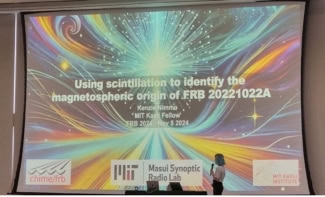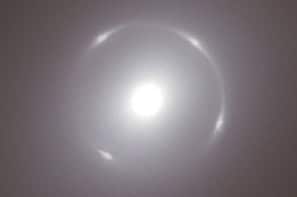
In September 2006 the brightest exploding star — or supernova — ever seen was spotted in a galaxy 240 million light years from Earth. Dubbed SN 2006gy, it was 100 times brighter than a typical supernova, leading some astrophysicists to conclude that it was created during the death throes of a star 90 or more times massive than our Sun. Now, however, researchers in the Netherlands think they know how such a massive star could have formed in the first place, while an independent team in the US has worked out how the explosion could have taken place. Both results are published in this week’s issue of Nature.
As a star gets older, it burns off all of its hydrogen and is left with a core of helium and heavier elements. If this core is more than twice as heavy as our Sun, astrophysicists believe that the star will collapse, causing a spectacular supernova explosion that leaves behind a black hole or neutron star. Several solar masses worth of material are ejected into the interstellar medium during a supernova, producing a fantastic display of light and colour.
However, the fate of massive stars with cores that are 40 times as heavy as our Sun is not well understood — making the origins of SN 2006gy a genuine mystery. The leading candidate is a theory that has been around for some time called “pulsed pair instability”. This suggests that the supernova was created not by a single massive explosion, but by the collision of two pulses of matter ejected from a massive star by two successive explosions.
Now, Stan Woosley and colleagues at the University of California at Santa Cruz claim to have shown that SN 2006gy was created in such a way. The instability is believed to occur when a massive star has exhausted its helium and starts to burn carbon and oxygen. This causes the star to contract and become much hotter than before, boosting the energy of the photons it produces. Indeed, the photons become so energetic that they can change into pairs of electrons and positrons.
Pressure drop
This process, in which kinetic energy is converted into matter, causes the pressure of the core to drop. The star responds by contracting further and burning even hotter until the pressure generated by this ferocious burning is so high that the star explodes and several solar masses of material are ejected. Woosley told physicsworld.com that this would produce a relatively small “supernova”, which in the case of SN 2006gy, would probably go unnoticed here on Earth.
After ejecting matter, the star begins to contract and the process repeats itself, ejecting matter for a second time. However, Woolsey believes that the fireworks really begin when the second pulse of matter catches up with the first and the collision produces an extraordinary burst of light. According to Woosley, such a collision could produce up to 100 times more light than an ordinary supernova because the collision occurs some distance from the star and its powerful gravitational attraction. As a result, most of the kinetic energy of the ejected particles can be converted into light. In a normal supernova, by contrast, 99% of the kinetic energy is consumed by overcoming gravity.
Woosley and colleagues tested their hypothesis by doing a computer simulation of the death of a star that began life at 110 solar masses, which suggested that such a star would explode twice in about 5.4 years and then collapse into a neutron star or black hole about 15 years after the first explosion. The team also calculated the light that would be emitted in the days after the second explosion, which they claim compares favourably to measurements made on SN 2006gy.
Colliding stars
While Woosley and colleagues have explained how such a bright supernova could occur, the question of how such a massive star could form in the first place has been addressed by Simon Portegies Zwart and Edward van den Heuvel of the University of Amsterdam in the Netherlands.
Most astrophysicists believe that massive stars were common in the early Universe, but it would be very unlikely for such a star to form much later on — as the SN 2006gy must have done if it exploded a mere 240 million years ago. An important clue as to the origin of the SN 2006gy star is that the supernova light suggests it had an abundance of hydrogen. This is puzzling because massive stars near death should have already burned off all their hydrogen.
Portegies Zwart and van den Heuvel believe that instead of being a massive isolated star that has grown old, the SN 2006gy star was the product of a series of “runaway” collisions between stars in a dense and young stellar cluster. Such collisions could cause a large star to get bigger and bigger by absorbing young hydrogen-rich stars. Eventually, such a star could become large enough to become a supernova — but it would also have a significant amount of hydrogen from the last star it absorbed.
Portegies Zwart and van den Heuvel performed computer simulations of runaway collisions, which showed that stars greater than 100 solar masses could be created by collisions over several million years. And if the last collision with a young star occurred about 100,000 before the supernova, there would be enough hydrogen left over to explain its presence in SN 2006gy. Portegies Zwart told physicsworld.com that once the supernova fades in a year or so the cluster should become visible, which will provide them with a way of testing their hypothesis.




